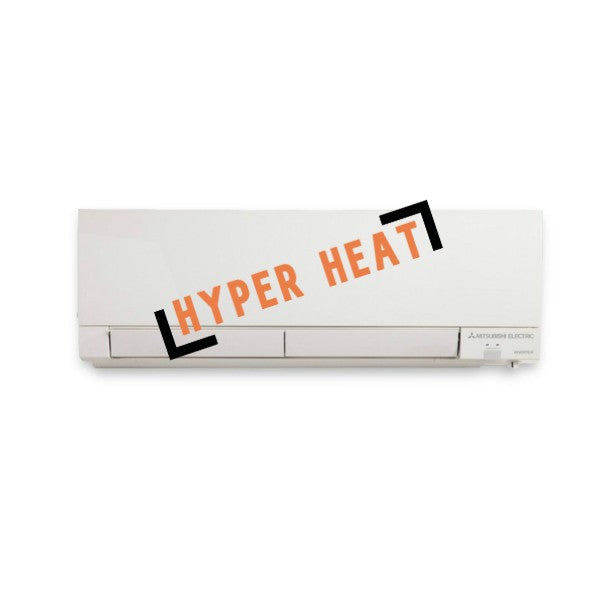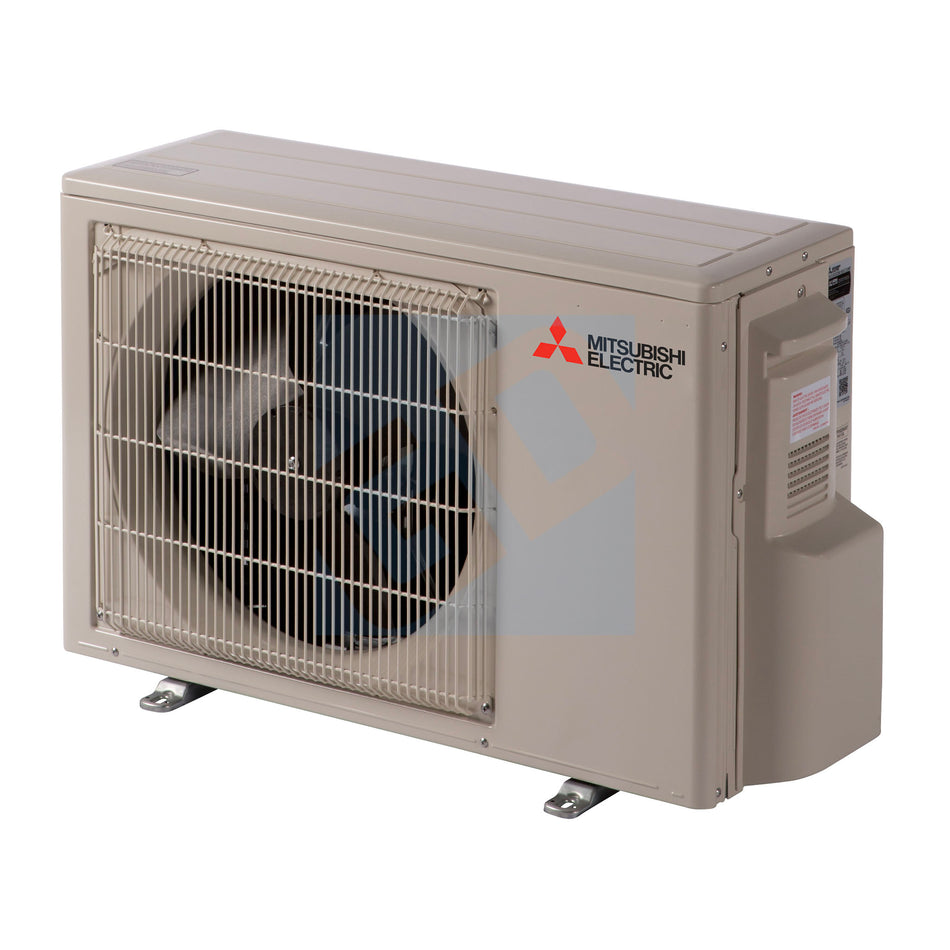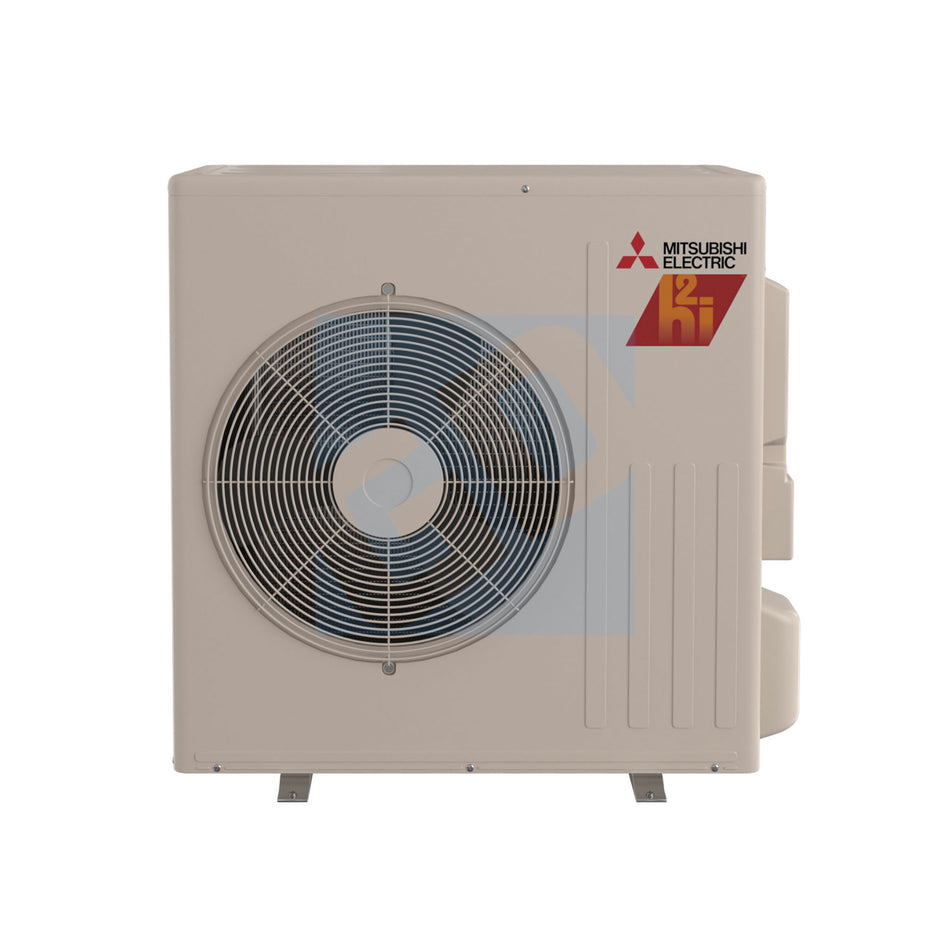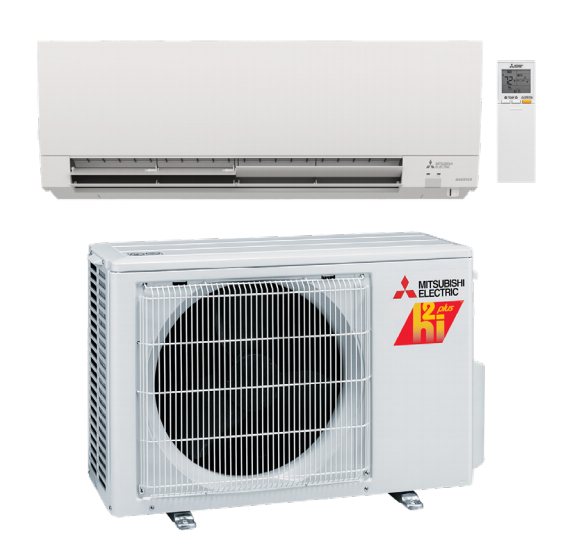Before we get into the advancement Mitsubishi made with their hyper heat systems, let's go over the basics of heat pumps.
A heat pump works by using the heat/cold from one place and transferring it to another place. In ductless systems, this transfer happens because the compressor (outdoor unit) pumps refrigerant between the indoor unit and itself.
Refrigerant either compresses or evaporates on coils in both units to heat or cool - whichever is called for. When the heat pump needs to absorb heat from the air, refrigerant is evaporated at low pressure on a heat exchanger coil. Taking the heat out of the air cools the air around the coil.
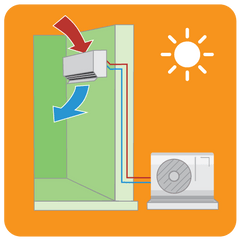
To transfer the absorbed heat from one coil to the other, it compresses the refrigerant. The compressed refrigerant condenses at high pressure and releases the absorbed heat in the opposite coil - heating the air that passes over it.

Even when it's cold outside, the air and ground always contain some heat. Air at 0° F contains 85 percent of the heat of air at 70° F.
Mitsubishi Hyper-Heating
What is Mitsubishi's Hyper-Heat?
Hyper-Heating H2I® was designed by Mitsubishi specifically to keep your home comfortable while outside gets as low as -13° F. In fact, hyper heat models provide 100% of their rated capacity all the way down to 23° F. Meaning even if it's below freezing outside, your mini-split won't miss a beat heating your home.
The H2i® hyper heat systems use enhanced compressor systems to provide 76% of their capacity even when it's -13° F outside. Any heat that's still in the air, they're able to pull out better than any other compressor to date. Mitsubishi's main goal was to make sure you won't need any supplemental heat sources to heat your home in the winter, even in the most extreme temperatures.
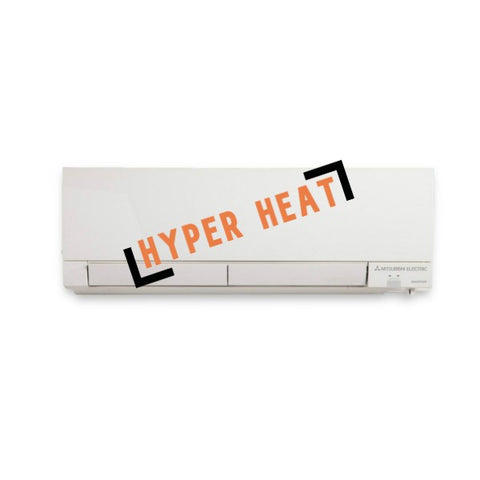
Other Hyper-Heat Features
Instant Hot Start
Have you ever gotten in your car in the wintertime without letting it heat up? Then you know the benefits of instant hot-start.
Without letting the system run idle to heat up, Mitsubishi designed their hyper heat systems to deliver instant hot air to your room. Once you turn your ductless unit on, it starts heating your room immediately.
If your mini-split isn't on a timer, it isn't running automatically to keep a set temperature, or you didn't get Kumo Cloud®, you're covered.
Minimal Energy Consumption
All ductless systems work on inverter technology. And like all heat pumps that use inverters, they deliver the precise amount of heat/cool air you need for your particular need.
But ductless systems take it one step further because they're individually "zoned." Zoning a system means it's responsible for heat/cooling a specific area. Once that area is heated/cooled to the proper temperature, that zone deactivates - saving you energy.
The reason ductless systems are unmatched in their zoning capabilities is each indoor unit scans the environment individually. Once it knows how much heat/cold it needs to meet that zones temperature requirements, the outdoor compressor (using inverter technology) delivers the exact heat/cold that zone needs.
With ductless systems, you're not turning on the furnace to heat or heat pump to cool your entire house. You're mini-split is reading your room individually, delivering exactly the right amount of heat, and using the exact amount of energy you need.
Comparing Mitsubishi's Models (Updated)
Let's compare three systems side-by-side:
- Mitsubishi WR 9,000 BTU 18 SEER2 Wall Mounted Heat Pump System
- Mitsubishi GS 9,000 BTU 28.4 SEER2 High-Efficiency Wall Mounted Heat Pump System (GL Substitute)
- Mitsubishi FS 9,000 BTU 29.8 SEER Hyper-Heat Wall Mounted Heat Pump System (FH Substitute)
WR Series |
GS Series (High-Efficiency) |
FS Series (Hyper-Heat) |
|
SEER2 Rating |
18 |
28.6 |
29.8 |
Cooling Capacity @ 95F |
10,000 BTU |
12,200 BTU |
12,000 BTU |
Heating Capacity @ 47F |
11,800 BTU |
15,900 BTU |
18,000 BTU |
HSPF2 Rating |
8.5 |
10.9 |
10.9 |
Minimum Heating Temp. |
5° F |
-4° F |
-13° F |
Minimum Cooling Temp. |
32° F |
14° F |
14° F |
Energy Star Rated |
No |
Yes |
Yes |
The FS hyper-heating model outperforms both comparable 9,000 BTU systems in almost every category. It's more efficient (SEER Rating) while heating down to -13° F, and it's also energy star rated.
If you're in a climate where extreme low temperatures are common, Mitsubishi's FS hyper-heat technology is probably a good fit for you.
Comparing Hyper-Heat to the Competition
What makes Hyper-Heating H2I® so much better than anything else?
While most traditional heat pumps aren't designed to handle extreme conditions & climates, Mitsubishi's Hyper-Heating H2i® can. But, Mitsubishi isn't the only manufacturer to make the leap into extreme cold.
Even though Mitsubishi designed and owns the technology, Fujitsu's Halcyon™ XLTH Low Temp Heating technology takes a play out of Mitsubishi's book. Fujitsu's Extra Low-Temperature Heating (XLTH) Series ductless systems are engineered to operate in temperatures down to -15ºF - slightly lower than Mitsubishi.
What's the difference between Mitsubishi's Hyper Heating H2i® and Fujitsu's XLTH?
In our opinion, Fujitsu's system is a workaround, and Mitsubishi's is the real deal. Let's go over how each work:
Mitsubishi's Hyper-Heating H2i®
Mitsubishi's hyper-heating H2i® compressor motor signals that a burst of heat is needed when the temperature gets below 40°F. Depending on the temperature, the motor revs up accordingly and the system absorbs the additional heat thrown off the compressor magnets. After the extra heat is absorbed, it's funneled to the back of the blower.
That process supercharges your heat output. That's how Mitsubishi's hyper-heating H2i® inverter compressor matches the heat that's needed and quickly responds to the dropping temperature outside.
Also with Mitsubishi's “flash injection” bypass circuit, you avoid the problem of decreasing amounts of refrigerant at sub-zero temperatures. Flash injection helps increase the amount of the refrigerant circulating between the indoor and outdoor units.
Refrigerant flow is increased when refrigerant is bypassed to the compressor. It gives the system more stable and continuous heating - even down at extreme temperatures. That's why Mitsubishi's hyper heat systems can provide 100% of their rated capacity all the way down to 23° F when other heat pumps can't.
Fujitsu's Halcyon™ XLTH Low Temp Heating
Fujitsu's Halcyon™ XLTH Low Temp Heating technology works a little differently. It uses a metal fan guard, a base heater and base drainage holes. The metal fan guard is more capable than plastic guards other heat pumps use to withstand colder temperatures. Including a base heater means when the temperature gets below 36°F, the built-in heater warms the base of the outdoor compressor. Warming the base allows the compressor to capture the warmers' heat, and doesn't allow condensation to freeze - which can damage your compressor. And the drainage holes let melted water (from snow and ice) to drain out of the unit.
Hyper Heat vs Traditional Systems
Most times when you have a traditional heat pump in your home, you're going to need to have an additional source of heat in the winter. There's really no other way around it.
Cost of the Systems
Traditional heat pumps have to catch up to the technological advancements of inverter-driven systems (which ductless systems are). And with an additional source of heat, there's always additional cost. In our Ductless vs Central Air post, we went over the "from scratch cost" of both central and ductless systems. We've found a lot of times ductless or a central air system aren't too far off from each other. And if you're going to include zoning, which comes standard for ductless, central air will usually be more expensive.
Energy Usage
Hyper heat systems use electricity while traditional systems use a variety of fuel sources. There's one advantage that electricity has over other fuel sources - every other source of fuel can be converted to it. Meaning, electricity can be made with any other source of energy (fuel), and in the coming years, most of the electricity we're going to be using will be sustainable.
Traditionally electricity rates have climbed over time. According to the US Energy Information Administration, electricity rates have risen around 8% on average year over year. Natural gas, on the other hand, has been decreasing on average. But as far as electricity goes, that's beginning to change. When more people start to use solar as their form of energy, their electricity rate will decrease, making electric heat more and more appealing.
Comfort & Convenience
Zoning your heating & cooling system gives you unmatched comfort. Each zone is set to the temperature you'd like, and your system ramps up or down to reach that zone's needs.
Central air systems can be zoned to match the ductless systems, but it's usually much more expensive than a mini-split. Ductless systems are automatically zoned. Think of it like air conditioning zones in your car. The driver and passenger can control their own temperatures, which makes everyone in your car more comfortable.
Each ductless system is heating/cooling independently of each other. Unlike central systems, each one turns on and off as needed. Saving you energy and customizing each room to your needs.
Hyper Heat or Not To Hyper Heat
There are a couple of questions we always ask before we recommend Hyper Heating.
- Is ductless going to be your main source of heat?
- Are you in a climate that gets below 0°F on a regular basis?
- Would you consider another brand?
If ductless is going to be your main source of heat, hyper heating H2i® is probably a good feature for you to have. In Maryland where our headquarters is, it doesn't get below 5°F degrees very often. But when it does, you don't want to be left out in the cold. Considering this is your only source of heat, you want to be covered.
In sub-zero temperatures, you want to make sure you're covered. And if you're in the Northern part of the US, Hyper Heating H2i® was made specifically for you in mind.
If you'd consider another brand, LG's Art Cool ductless systems cover you down to -4°F. Mitsubishi's GL series only heats at 4°F and above. There's only a 10° difference, but it could mean the world to you if you were considering the GL series.
All in all, there's no doubt Hyper Heating H2i® is a breakthrough for ductless systems. They paved the way for some of the most efficient and highest performing systems. And they're still the #1 brand for ductless in the US.


